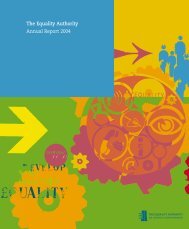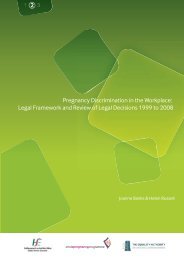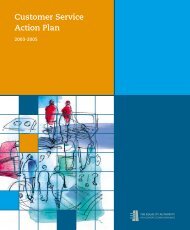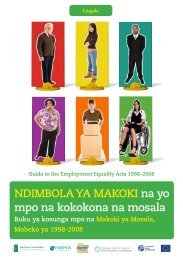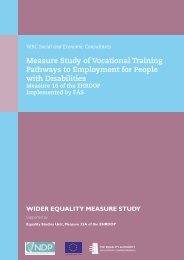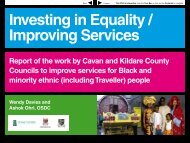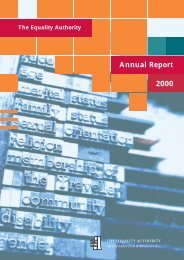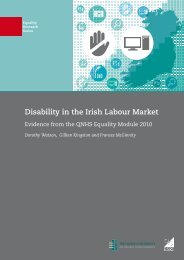Equality and Diversity - Building a Culture of ... - Equality Authority
Equality and Diversity - Building a Culture of ... - Equality Authority
Equality and Diversity - Building a Culture of ... - Equality Authority
Create successful ePaper yourself
Turn your PDF publications into a flip-book with our unique Google optimized e-Paper software.
Introduction<br />
This resource is intended to support young people<br />
in critically exploring the concepts <strong>of</strong> equality<br />
<strong>and</strong> diversity <strong>and</strong> in acting to build a culture<br />
<strong>of</strong> equality within their own environment <strong>and</strong><br />
within society. Looking specifically at equality<br />
<strong>and</strong> diversity within the school, community <strong>and</strong><br />
society, the resource provides an opportunity<br />
for students to increase their knowledge <strong>and</strong><br />
underst<strong>and</strong>ing <strong>of</strong> equality, develop the skills<br />
to critically analyse inequality, <strong>and</strong> become<br />
empowered to actively promote equality within<br />
their school <strong>and</strong>/or community.<br />
Using a variety <strong>of</strong> active learning methodologies,<br />
the resource enables students to:<br />
Underst<strong>and</strong> <strong>and</strong> appreciate the levels <strong>of</strong><br />
diversity within their environment <strong>and</strong> society<br />
Underst<strong>and</strong> the nature <strong>of</strong> perceptions <strong>and</strong><br />
stereotypes <strong>and</strong> critically analyse their effects<br />
on people’s lives <strong>and</strong> life chances<br />
Explore the concept <strong>of</strong> equality <strong>and</strong> its<br />
four dimensions – equal opportunities<br />
<strong>and</strong> outcomes, respect <strong>and</strong> recognition,<br />
participation in decision making, <strong>and</strong><br />
equality <strong>of</strong> relationships<br />
Identify <strong>and</strong> analyse equality issues within<br />
their school <strong>and</strong> society <strong>and</strong> identify how<br />
equality could be promoted<br />
Learn about equality <strong>and</strong> anti-discrimination<br />
legislation in their jurisdiction, the groups it<br />
protects <strong>and</strong> how to make a complaint<br />
Take action to promote equality in their<br />
school <strong>and</strong>/or community<br />
Outline <strong>of</strong> the Resource<br />
The resource is divided into four sections, each<br />
with a number <strong>of</strong> lessons. The resource uses<br />
active learning methodologies throughout to<br />
bring the concepts <strong>and</strong> experiences <strong>of</strong> equality /<br />
inequality to life for the students.<br />
Section 1 <strong>Diversity</strong><br />
Lessons 1-4 enable students to examine the<br />
nature <strong>of</strong> diversity, appreciate how it enriches<br />
our lives <strong>and</strong> carry out a diversity audit <strong>of</strong><br />
their community.<br />
Section 2 Perceptions <strong>and</strong> Stereotypes<br />
Lessons 5-9 challenge students to look at how<br />
their perceptions influence how they see people<br />
<strong>and</strong> behaviour, to recognise the stereotypes<br />
we all hold <strong>of</strong> certain groups <strong>of</strong> people, <strong>and</strong> to<br />
reflect on the negative effect that stereotyping<br />
has on people’s lives, <strong>and</strong> ultimately on their<br />
lack <strong>of</strong> equality in society.<br />
Section 3 Exploring <strong>Equality</strong><br />
Lessons 10-21 take students from a simple<br />
underst<strong>and</strong>ing <strong>of</strong> equality to a deeper analysis<br />
<strong>of</strong> the concept through exploring the four<br />
dimensions <strong>of</strong> equality - equal opportunities<br />
<strong>and</strong> outcomes, respect <strong>and</strong> recognition,<br />
participation in decision making, <strong>and</strong> equality<br />
<strong>of</strong> relationships. They then examine these<br />
dimensions in relation to the stories <strong>of</strong><br />
inequality experienced by five groups <strong>of</strong><br />
people – young migrants, young people with<br />
disabilities, young LGBT people, migrant<br />
workers, <strong>and</strong> mushroom workers.<br />
Section 4 <strong>Equality</strong> <strong>and</strong> the Law<br />
Lessons 22-27 enable students to learn about<br />
the legislation in both Irel<strong>and</strong> <strong>and</strong> Northern<br />
Irel<strong>and</strong> <strong>and</strong> to explore the extent to which<br />
it protects people from discrimination <strong>and</strong><br />
promotes equality. They identify which groups<br />
<strong>of</strong> people are most likely to be discriminated<br />
against, which groups are protected by the<br />
law, <strong>and</strong> how the law operates in practice.<br />
The students can then analyse a number<br />
<strong>of</strong> case studies <strong>of</strong> complaints taken in<br />
both jurisdictions, make decisions on their<br />
outcomes, <strong>and</strong> compare them with the actual<br />
decisions taken.<br />
Section 5 Creating a <strong>Culture</strong><br />
<strong>of</strong> <strong>Equality</strong><br />
Finally, Lessons 26-27 encourage students to<br />
reflect on what they have learned throughout<br />
the module, to create their own vision <strong>of</strong><br />
what equality should look like in their school,<br />
community <strong>and</strong> society, <strong>and</strong> develop a list <strong>of</strong><br />
the changes required to realise their vision.<br />
Introduction 5




